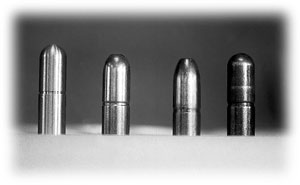|
 |
| The Bullets tested (L - R): Barnes 500 grain, Woodleigh 500 grain, Speer African Grand Slam 500 grain, A-Square 475 grain. |
The group which had hunted the elephant had worked long and hard, and the rest of the group were there to learn about shot placement, how to approach a downed elephant, where to place an insurance shot, and all the hundred and one little techniques of experience from the instructors, those little things which make the difference between a long and successful career and ending up as a little puddle of strawberry jam in the African dirt before your career has even begun. The elephant in question had been hit by three well-placed bullets;- one in the head with a .458, one in the neck with a .416 and a body shot with a .460 Weatherby. All the bullets were monometal solids, and none had exited. This started a train of thought going in my little mind, to wit:- Do monometal bullets penetrate as well as the generally heavier and denser conventional solids in heavy rifles, assuming all goes well with the latter? I was surprised to find that none of these monometal bullets had exited the elephant, and wondered if a well constructed solid might not have done so.
Some years ago, the only bullets available for maximum penetration on heavy, dangerous game were conventional solids - that is, lead cored bullets which were (generally) encased in a steel jacket with a copper wash on the surface. Such bullets were supposed to keep their shape no matter what, and penetrate to great depth. Such performance was needed, especially on elephant if the bullet was to reach the brain or other vital organs protected by massive bones and resilient tissue, hidden right in the depths of a huge animal. The trouble was, they didn’t always keep their shape. Solids were prone to a variety of failures such as fishtailing, rivetting, bending, splitting or even breaking up completely. Such misbehaviour led to very erratic penetration or even none at all, and was termed as “sick leave material” by National Parks personnel of yore. This, of course, was due to the likelihood that if a solid pulled such a stunt on a heavy, dangerous and irate animal that you, the shooter, would shortly be spending a considerable time flat on your back in hospital listening to your bones knit. If you were lucky. This in turn gave rise to the monometal bullets, pioneered by A-Square and their Monolithic bullet. Such bullets have no separate core and jacket, but as the name suggests are made of a hard homogeneous brass or bronze-like metal. Such bullets resisted deformation much better than the older, failure-prone lead cored solids, and soon became very common in the safari industry.
At the same time, though, great strides were being made in the construction of conventional solid bullets. A variety of premium solids are now available which resist deformation far better than the older specimens. Now the question remains - which one penetrates better?
This question is not as straightforward as it may appear at first, especially with regard to the .458 Winchester Magnum (one of the most popular heavies in this part of the world). .458 solid bullets are standardised at 500 grains. However, monometal bullets are less dense than conventional solids, so a 500 grain monometal bullet will be appreciably longer than a conventional 500 grainer. While 500 grain monometal bullets are available, they are generally loaded in bigger cases such as the Lott, Watts or Ackley, as they intrude too much on the .458’s already limited powder space. Depending on the maker, monometal bullets for the .458 are in the region of 465 to 475 grains. They are therefore the same length, size and shape as conventional solids, but some 25 to 35 grains lighter. On the other hand, velocities achievable with these lighter bullets are somewhat higher. So, does the lighter weight and lesser density of monometal bullets compromise their penetration, or do their somewhat higher velocities lead to greater performance? Generally speaking, momentum has been found to be of greater importance than velocity in heavy rifles, but .458’s have been found wanting in the velocity department due to the aforementioned limited powder capacity, so might not a bit less bullet weight and a bit more velocity be advantageous in this specific instance? There are many questions and a lot more opinions with regard to this issue, so I resolved to do a few tests in order to try and resolve a few of them.
|